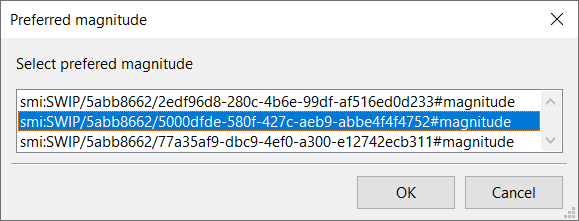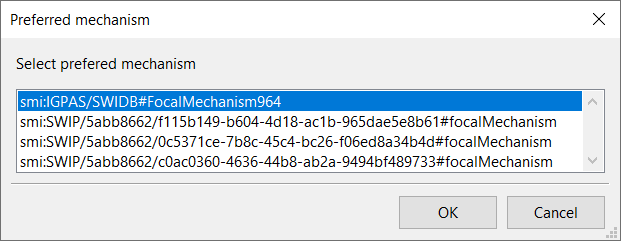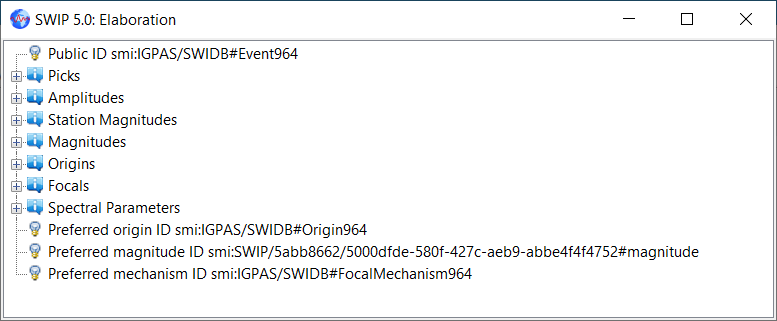This module contains small functions which, due to their simplicity, have been gathered in one plugin. In the menu, they are grouped under the Tools submenu. In addition, in the Tool submenu, there are functions supported by other plugins and described in other chapters. These include: determining theoretical phases, displaying channel responses, etc.
The functionals described in this chapter are
Moduł ten zawiera drobne funkcje, które ze względu na ich prostotę zgromadzono w jednej wtyczce. W menu są one zgrupowane w podmenu Tools. Oprócz tego w podmenu Tool są czynności odsługiwane przez inne wtyczki i opisane w innych rozdziałach. Są to m.in.: wyznaczanie faz teoretycznych, wyświetlanie charakterystyki kanałów, itp.
Czynności opisane w tym rozdziale są to:
| Table of Contents |
|---|
Channels status report
The Tools → Channels state command displays information about the loaded seismic channels in the report window: their code, time range or ranges of times of loaded parts of recordings and sampling frequency, e.g.
...
Listing of parameters of seismic stations and channels loaded into the program
Polecenie The Tools → List loaded parameters powoduje wypisanie w oknie raportu informacji o wczytanych parametrach kanałów sejsmicznych. parametry mogły być wczytane razem z wczytaniem zapisów sejsmicznych lub osobnym poleceniem np. czytania plików dataless. W oknie raportu wypisywane są: okres ważności parametru, położenie stacji, wzmocnienie i częstotliwość próbkowania np command displays information about the loaded parameters of seismic channels in the report window. parameters could be loaded together with seismic records or a separate command, e.g. reading dataless files. The report window displays: parameter validity period, station location, gain, and sampling frequency, e.g.
Adding a comment to the event
Polecenie Tools The Tools → Add comment to the event command allows you to add a comment to the event pozwala dopisać komentarz do zjawiska. Można dopisać dowolną liczbę komentarzy. Po wybraniu narzędzia pojawi się okno w którym wpisujemy komentarz - jeden wiersz.
. You can add any number of comments. After selecting the tool, a window will appear in which you can enter a comment - one line.
Comments are visible, among others, in the elaboration window, in the Comments table, e.gKomentarze są widziane w oknie opracowań w tablicy Comments, np.:
Setting preferred event parameters
Struktura danych QuakeML pozwala zapisywać wiele różnych lokalizacji (origin), magnitud i mechanizmów wstrząsu liczonych różnymi metodami dla jednego zjawiska. Aby było wiadome, które z tych wyników należy wybrać np. przy eksporcie danych można określić preferowany parametr. Niektóre moduły same ustawiają ten parametr. Można też ręcznie ustawić lub skasować preferencje.
Preferowaną lokalizację ustawia się poleceniem Tools → Set preferred origin. Pojawia się lista wyboru ID istniejących lokalizacji np.:
w której trzeba zaznaczyć ID jednej lokalizacji i kliknąć Ok.
Preferowaną magnitudę ustawia się poleceniem Tools → Set preferred magnitude. Pojawia się lista wyboru ID istniejących magnitud np.:
The QuakeML data structure allows you to store many different origins, magnitudes, and focal mechanisms calculated using different methods for a single event. In order to know which of these results should be selected, e.g. when exporting data, you can specify the preferred parameter. Some modules set this parameter themselves. You can also manually set or clear preferences.
The preferred origin is set with Tools → Set preferred origin. A selection list of IDs of existing locations appears, e.g.:
in which you need to select the ID of one origin and click Ok.
The preferred magnitude is set with the command Tools → Set preferred magnitude. A selection list of IDs of existing magnitudes appears, e.g.:
in which you need to select the ID of one magnitude and click w której trzeba zaznaczyć ID jednej magnitudy i kliknąć Ok.
Preferowany mechanizm wstrząsu ustawia się poleceniem Tools → Set preferred mechanizm. Pojawia się lista wyboru ID istniejących mechanizmów np.:
w której trzeba zaznaczyć ID jednego mechanizmu i kliknąć Ok. ID preferowanych parametrów wypisywane są w oknie opracowań, np.
The preferred focal mechanizm is set with the command Tools → Set preferred mechanizm. A selection list of IDs of existing focal mechanizms appears, e.g.:
in which you need to select the ID of one focal mechanizm and click Ok
IDs of preferred parameters are listed in the elaboration window, e.g.
If the preference is already set to the ID of the preferred parameter (e.g. origin), the list of possible IDs is preceded by Jeżeli preferencja jest już ustawiona do ID preferowanego parametru (np. lokalizacji) lista możliwych ID poprzedzona jest pozycją --DISMISS--. Wybranie DISMISS spowoduje usunięci tej preferencji bez wybrania innejSelecting DISMISS will remove this preference without selecting another.






